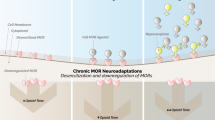Abstract
Purpose of Review
Opioid use disorder (OUD) is a chronic disorder in which a person loses control over the use of opioids, develops a compulsive behavior, and defends the use despite knowing the negative consequences. There are numerous treatments for OUD, including buprenorphine. Since it is displacing a full agonist opioid, precipitated withdrawal can occur with standard inductions involving buprenorphine.
Recent Findings
Case reports have noted success with a low-dose initiation of buprenorphine, which is different from typical protocols, relatively limited by adverse effects when patients were recently administered full agonists. A cohort investigation studied the use of a transdermal patch as part of the protocol, which was fairly well tolerated.
Summary
While ongoing research is being conducted on this topic, recent case studies and smaller cohort studies have demonstrated the feasibility of a trial to treat OUD with low-dose initiation of buprenorphine.
Similar content being viewed by others
Data Availability
All data presented in this review is available on PubMed.
References
Kumar R, Viswanath O, Saadabadi A. Buprenorphine. In: StatPearls [Internet]. Treasure Island (FL): StatPearls Publishing; 2022 [cited 2023 Jan 22]. Available from: http://www.ncbi.nlm.nih.gov/books/NBK459126/.
Hoffman KA, Ponce Terashima J, McCarty D. Opioid use disorder and treatment: challenges and opportunities. BMC Health Serv Res. 2019;19(1):884.
Edinoff A, Murnane K, Rosa C, Giepert S, Cornett E, Kaye D, et al. Physiologic considerations in opioid addiction. In: Substance use and addiction research. 1st ed. Academic Press Inc.; 2023. p. 204–10.
Brown KG, Capili B. The pathophysiology of and nursing interventions for opioid use disorder. Am J Nurs. 2020;120(6):38–46.
Milivojevic V, Sinha R. Central and peripheral biomarkers of stress response for addiction risk and relapse vulnerability. Trends Mol Med. 2018;24(2):173–86.
Walsh SL, Eissenberg T. The clinical pharmacology of buprenorphine: extrapolating from the laboratory to the clinic. Drug Alcohol Depend. 2003;70(2 Suppl):S13-27.
Bell J, Strang J. Medication treatment of opioid use disorder. Biol Psychiatry. 2020;87(1):82–8.
Buresh M, Stern R, Rastegar D. Treatment of opioid use disorder in primary care. BMJ. 2021;19(373):n784.
Webster L, Gudin J, Raffa RB, Kuchera J, Rauck R, Fudin J, et al. Understanding buprenorphine for use in chronic pain: expert opinion. Pain Med. 2020;21(4):714–23.
Heidbreder C, Fudala PJ, Greenwald MK. History of the discovery, development, and FDA-approval of buprenorphine medications for the treatment of opioid use disorder. Drug Alcohol Depend Rep. 2023;1(6):100133.
Urits I, Pham C, Swanson D, Berardino K, Bandi P, Amgalan A, et al. The utilization of buprenorphine in chronic pain. Best Pract Res Clin Anaesthesiol. 2020;34(3):355–68.
Shearer D, Young S, Fairbairn N, Brar R. Challenges with buprenorphine inductions in the context of the fentanyl overdose crisis: a case series. Drug Alcohol Rev. 2022;41(2):444–8.
Varshneya NB, Thakrar AP, Hobelmann JG, Dunn KE, Huhn AS. Evidence of buprenorphine-precipitated withdrawal in persons who use fentanyl. J Addict Med. 2022;16(4):e265–8.
Hämmig R, Kemter A, Strasser J, von Bardeleben U, Gugger B, Walter M, et al. Use of microdoses for induction of buprenorphine treatment with overlapping full opioid agonist use: the Bernese method. Subst Abuse Rehabil. 2016;20(7):99–105.
DeWeese JP, Krenz JR, Wakeman SE, Peckham AM. Rapid buprenorphine microdosing for opioid use disorder in a hospitalized patient receiving very high doses of full agonist opioids for acute pain management: titration, implementation barriers, and strategies to overcomes. Subst Abuse. 2021;42(4):506–11.
Rozylo J, Mitchell K, Nikoo M, Durante SE, Barbic SP, Lin D, et al. Case report: successful induction of buprenorphine/naloxone using a microdosing schedule and assertive outreach. Addict Sci Clin Pract. 2020;15:2.
Baumgartner K, Salmo E, Liss D, Devgun J, Mullins M, Galati B, et al. Transdermal buprenorphine for in-hospital transition from full agonist opioids to sublingual buprenorphine: a retrospective observational cohort study. Clin Toxicol Phila Pa. 2022;60(6):688–93.
Moe J, Badke K, Pratt M, Cho RY, Azar P, Flemming H, et al. Microdosing and standard-dosing take-home buprenorphine from the emergency department: a feasibility study. J Am Coll Emerg Physicians Open. 2020;1(6):1712–22.
Wong JSH, Nikoo M, Westenberg JN, Suen JG, Wong JYC, Krausz RM, et al. Comparing rapid micro-induction and standard induction of buprenorphine/naloxone for treatment of opioid use disorder: protocol for an open-label, parallel-group, superiority, randomized controlled trial. Addict Sci Clin Pract. 2021;16(1):11.
Author information
Authors and Affiliations
Contributions
A. N. E. was responsible for the conception of this manuscript. A. N. E., O. F., N. S., and A. Z. were responsible for the writing of the first draft of the manuscript with revisions. A. N. E., E. D. J., D. M. W., E. M. C., A. M. K., K. L. S., and A. D. K. were responsible for all subsequence revisions. All authors give consent for the publication of this manuscript in this journal.
Corresponding author
Ethics declarations
Ethics Statement
This narrative review did not require consent from subjects or review by an institutional review board.
Conflict of Interest
The authors declare no competing interests.
Human and Animal Rights and Informed Consent
This article does not contain any studies with human or animal subjects performed by any of the authors.
Additional information
Publisher's Note
Springer Nature remains neutral with regard to jurisdictional claims in published maps and institutional affiliations.
Rights and permissions
Springer Nature or its licensor (e.g. a society or other partner) holds exclusive rights to this article under a publishing agreement with the author(s) or other rightsholder(s); author self-archiving of the accepted manuscript version of this article is solely governed by the terms of such publishing agreement and applicable law.
About this article
Cite this article
Edinoff, A.N., Fahmy, O.H., Spillers, N.J. et al. Low-Dose Initiation of Buprenorphine: A Narrative Review. Curr Pain Headache Rep 27, 175–181 (2023). https://doi.org/10.1007/s11916-023-01116-3
Accepted:
Published:
Issue Date:
DOI: https://doi.org/10.1007/s11916-023-01116-3



